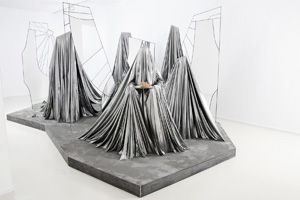In the group exhibition “Penal Colony” (Museum of Art, Ein-Harod, 2008), Helfman exhibited in the portico a protoma on its unique crude pedestal stand in front of a curtain. In the performance space they created, like a stage without a stage, the statue and curtain fabric functioned both as actors and as stage scenery devoid of actors, as props. The curtain fabric, which marked the floor of the portico as a stage and undermined the distinction between interior and exterior, between forward and backward, partly covered the museum’s portico, but only in order to reveal that there was nothing to conceal, to juxtapose appearance and disappearance in a way that cancels the distinction between them.
In the present installation, the motifs that appear in the two installations described above are repeated. The installation is a stage, upon which are flat sculptural elements covered in shiny, silvery synthetic cloth. The outlines drawn by the cloth on the stage hint at human bodies, sculptured or real, which lie beneath it. The presence of the draping creates a delayed scene; it strengthens the feeling that possible life exists after it, life waiting to be exposed and emerge. The frozen scene upon the stage – a scene that is both sculptural performance and scenery for a performance that will never take place – impacts the behavior of the viewers surrounding it, which becomes staged in every respect concerning their attitude towards it, the ostensible execution of a script written in advance.
Less Reading...
